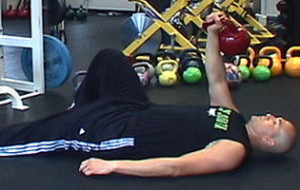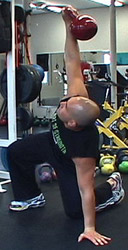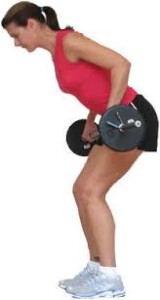See Active Blog For Hand Weight Video
Hand weights will always be one of the best ways to add resistance to your workout routine because of their versatility. With hand weights, you aren’t tied to specific gym equipment and can do your resistance exercises anywhere at anytime. Additionally, you can modify a host of existing bodyweight exercises by incorporating hand weights into them, and you aren’t limited to the specific motions and muscle groups targeted by gym machines. Ideally, you should purchase more than one set of free weights, getting dumbbells ranging from 5 to 20 pounds so you can change up the weight according to the difficulty of the exercise.
Turkish Get Up
Start with a light dumbbell when first learning the movement, and progressing up to a barbell or kettlebell.When first learning the movement it is best to practice with either bodyweight or a very light object. Just because you may be strong, don’t think you can just pick up a heavy weight and start doing this, as you may be setting yourself up for injury.
In this one simple drill you get a whole host of fantastic benefits, such as:
- Core strength and stability
- T-spine mobility
- Hip mobility
- Hip extension (glute) strength
- Gleno-humeral (shoulder) stability
- Body awareness and proprioception
- Etc.
1. Lying on the floor, safely move the implement into a locked out position straight up with your right hand. Your shoulder should be tight in the socket. Your right leg will be cocked, your right foot alongside your left knee.
Safely Move The Implement Into A Locked Out Position.
2. Pushing off your right foot, roll onto your left hip and up onto your left elbow.
3. Push up onto your left hand.
Roll Onto Your Left Hip & Push Up Onto Your Left Hand.
4. Holding yourself up on your left hand and right foot, bring yourself up off the ground, and thread your left leg back to a kneeling position. You are now left knee on the floor, right foot on the floor, and implement locked out overhead in your right hand.
As stated, your arm should be locked out. You will be stronger in this position than in a flexed position, where the muscles would be doing all the work. This is a whole body exercise and particularly a shoulder developer, it is not meant to tire your arms out.
5. From the kneeling position take in a deep breath, tighten up, and lunge forward to a standing position
Lunge Forward To A Standing Position.
6. Reverse the process to come back down to the floor. Remember that a Turkish Get-Up is not complete until you return to the start position. The descent is one of the hardest parts of the exercise.
Chest/Bench Press
Doing a chest press with dumbbells instead of a barbell can add a different element to your chest exercises, since both arms now have to work independently from one another. This is great for working both sides of the body, and the dumbbell chest press makes a nice complement to the barbell exercise.
1. Lie down on a bench or step and begin with the weights in each hand straight up over the chest, palms facing out.
2. Bend the elbows and lower the arms down until the elbows are just below the chest (arms should look like goal posts).
3. Press the weights back up without locking the elbows and bring them close together.
4. Repeat for 1 to 3 sets of 8 to 16 reps.
Lie on a ball, bench or floor with abs contracted. Begin with weights straight up over chest, elbows slightly bent. Bend the elbows and lower arms until the elbows are just below shoulder level (arms should look like a goal post). Contract the chest and push arms up, but don’t allow weights to touch at the top.
Barbell Row
Holding bar or weights in front of thighs, bend knees and tilt torso forward to about 45 degrees, abs in tight. Take the weight out, following line of thighs, then squeeze the back to draw weight in towards belly button. Avoid this move if you have back problems.
The barbell row involves pulling a barbell from arm’s length into the upper abs in a bent-over position; joint movements occur at the shoulder blades, shoulders and elbows. During the barbell row, the shoulder blades adduct, or retract, and the elbows flex, or bend. The shoulders move through transverse extension, which involves moving the upper arms out and away from the chest. The muscles responsible for these body movements are the muscles of the back and arms.
Overhead Press
Sit or stand holding weights in hands, elbows bent and weights next to shoulders. Straighten elbows and push weights overhead, palms facing each other and slightly in front of head. Lower arms and repeat.
The overhead press is also known as a shoulder press. Your elbows are bent with your hands near your shoulders. You hold onto your resistance tool in your hands, then straighten your arms overhead and press up the resistance. The movement repeats as you bend and straighten your arms. Your deltoids — the shoulders — contract as you press up the weight.
Dumbbell Front Raises
1. Hold light-medium weights with arms straight down, palms face the thighs.
2. Slowly lift arms up to shoulder level keeping elbows slightly bent.
3. Exhale and lower back down.
4. This exercise can also be done with a light barbell or, if you’re using heavier dumbbells, you can alternate arms.
5. Repeat for 1 to 3 sets of 12-16 repetitions, with a 20-30 second rest between sets.
Stand with feet hip-width apart, abs in and torso upright with medium weights resting in front of thighs (palms face the thighs). Lift arms to shoulder level, elbows slightly bent and palms facing the floor. Lower and repeat.
Concentration Curls
1. Sit down at the edge of a flat bench that has a dumbbell right in front of it.
2. Use the right arm to pick it up the dumbbell and place the back of that upper arm on top of your inner right thigh (around three and a half inches away from the front of the knee). Rotate the palm of the hand until it is facing forward away from your thigh. Your arm should be extended at arms length and the dumbbell should be above the floor. This will be your starting position.
3. While holding the upper arm stationary, curl the weights forward while contracting the biceps as you breathe out. Only the forearms should move. Continue the movement until your biceps are fully contracted and the dumbbells are at shoulder level. Squeeze the biceps and hold the contracted position for a second.
4. Slowly begin to bring the dumbbells back to the starting position as your breathe in. Avoid swinging motions at any time.
5. Repeat for the recommended amount of repetitions. Then repeat the movement with the left arm.
Concentration Curls
Kneel or sit in a chair and prop right arm on the inside of right leg, weight in hand and palm facing out. Contract the bicep to pull weight towards the shoulder (without touching the shoulder). Lower and repeat.
Dumbbell Kickbacks
1. Start with a dumbbell in each hand and your palms facing your torso. Keep your back straight with a slight bend in the knees and bend forward at the waist. Your torso should be almost parallel to the floor. Make sure to keep your head up. Your upper arms should be close to your torso and parallel to the floor. Your forearms should be pointed towards the floor as you hold the weights. There should be a 90-degree angle formed between your forearm and upper arm. This is your starting position.
2. Now, while keeping your upper arms stationary, exhale and use your triceps to lift the weights until the arm is fully extended. Focus on moving the forearm.
After a brief pause at the top contraction, inhale and slowly lower the dumbbells back down to the starting position.
3. Repeat the movement for the prescribed amount of repetitions.
Variations: This exercise can be executed also one arm at a time much like the one arm rows are performed.
Also, if you like the one arm variety, you can use a low pulley handle instead of a dumbbell for better peak contraction. In this case, the palms should be facing up (supinated grip) as opposed to the torso (neutral grip
Bend torso forward until you’re at 45 degrees or parallel to the floor, elbows bent and next to ribcage. Contract triceps to straighten elbows, bringing weight up slightly above hips. Keep the abs tight and raise torso if this hurts your lower back or hamstrings.
Tricep Dips
Toning your triceps — the muscles that run on the backside of your upper arm from your shoulder to your elbow — is one way to really help prep your arms for tank tops. Triceps Dips are a great, basic exercise for working your triceps. What’s more? They’re pretty easy to do and don’t require much equipment.
1. Position your hands shoulder width apart on a secured bench or stable chair.
2. Move your booty in front of the bench with your legs bent and feet placed about hip width apart on the floor.
3. Straighten out your arms and keep a little bend in your elbows in order to always keep tension on your triceps and off your elbow joints.
4. Now slowly bend at your elbows and lower your upper body down towards the floor until your arms are at about a 90 degree angle. Be sure to keep your back close to the bench.
5. Once you reach the bottom of the movement, slowly press off with your hands, and push yourself straight back up to the starting position.
6. Begin sitting on a step or chair with hands next to thighs. Balance on your arms, moving backside in front of the step with legs straight (harder) or bent (easier). Bend the elbows and lower body a few inches, keeping the shoulders down and the elbows parallel to one another and at 90 degrees. Push back up to starting position and repeat.
Don’t allow your neck to sink and your ears to fall close to your shoulders. Also, straighten your legs as you get stronger, this will make the exercise harder.









